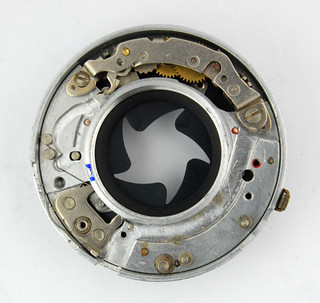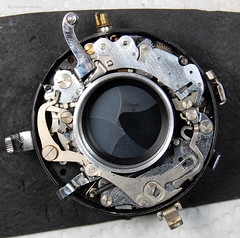Leaf shutter

|
| Partially-disassembled Compur leaf shutter image by Hans Kerensky (Image rights) |

|
| Prontor SVS image by Hans Kerensky (Image rights) |
Contents
Description
A leaf shutter is a shutter as found in certain cameras, using of a small number of identical overlapping metal blades, called the leaves, to open and close in order to expose a photograph. It is usually placed near the iris within the camera lens. The leaves are arranged in a circular pattern, suitably pivoted near the housing periphery, and made to move in a rapid oscillating fashion such that they together uncover the common central area for a predetermined period of time, enabling a picture to be taken. The shutter mechanism is governed by a clockwork mechanism and powered by a strong spring tensioned by setting the shutter before each exposure. The delay between opening and closing the blades determines the exposure time which usually may be adjustable within a specific range for the photographer to choose from. The shutter may be equipped with a delay action mechanism which, when set and released, triggers the shutter after a short period of time, in the region of 10 seconds. A threaded socked my also be present for attaching a wire release for the photographer’s convenience.
The leaf shutter allows synchronising flash at every available shutter speed, due to the fact that the whole picture area is exposed simultaneously, which is not always the case using the focal plane shutter.
Most leaf shutters for folding cameras have two threads mounts for the the lenses, one in the front side and one in the back. The reason is that most of these shutters have a built-in iris diaphragm. The lenses for these cameras are two-part lenses, each part delivered in an own lens barrel with thread. The reason is that the lenses work best when the diaphragm is placed between certain elements of the lens. This construction allowed also the concept of convertible lenses.
The manufacture of leaf shutters is highly specialized, and usually not made by the camera makers them selves. Common types of shutters are the German Compur and Prontor, and the Japanese Copal and Seikosha.
Depending on the way the shutter is arranged with respect to the lens, it is referred to as "between-lens" or "behind the lens" shutter.
Pros
- Leaf shutters can synchronise a flash at any available shutter speed.[1]
- They are generally more compact, less noisy and more durable than focal plane shutters.
- They do not distort the image of moving objects (rolling shutter).
Cons
- With large aperture lenses and fast shutter speeds, the very fastest shutter speeds are only available at smaller apertures
- Incorporating central shutter in large aperture telephoto lenses is a problem
- Leaf shutters are typically not capable of shutter speeds as high as modern focal plane shutters; usually the highest speed possible with a leaf shutter is 1/500th of a second (when?). So sometimes users with leaf shutters have no use ND filters to shoot at maximum aperture at day (e.g. portrait with background blur).
- Cameras using leaf shutters must either have a shutter in each lens, like the Hasselblad 500, or have the shutter in the camera body, which limits the range of possible focal lengths and the maximum aperture, like the Paxette.
Notes
- ↑ This is particularly true when electronic flashes connected to the X sync socket are concerned. Flashbulbs of different types, with different time to peak, various flash duration and connected to different sync sockets (e.g. X, M or F) have certain limitations in this aspect - for example S-class flashbulbs can be used at shutter speed not shorter than 1/20 s.
Links
- leaf shutters at licm.org.uk
- leaf shutters table
- Up and Down with Compur (German version) (includes relevant information about leaf shutters history), by Klaus-Eckard Riess in his camera site